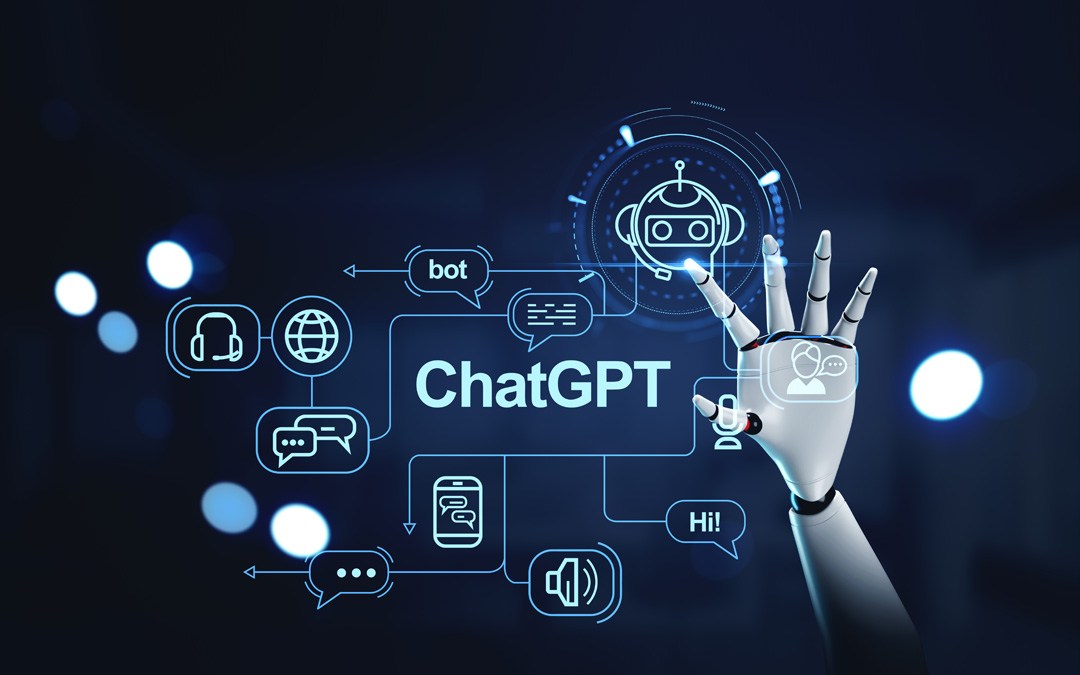
by Ebani Advertising | Mar 9, 2024 | Blog
The advent of ChatGPT has rekindled apocalyptic anxieties regarding artificial intelligence (AI) usurping human roles in the workforce. But how valid are these concerns? Recent findings reveal that while 62% of Americans anticipate AI will significantly influence jobs and employment within the next two decades, only 28% foresee a personal impact.
Experts from Harvard Business School weigh in on the potential shifts AI may introduce to the workforce and the crucial skills required for future success.
Prepare for Major Workforce Shifts
Today’s AI tools, powered by deep learning, are set to drastically alter the job market, phasing out numerous positions and modifying countless others. This shift will profoundly affect knowledge workers, historically shielded from automation and globalization, signalling a major transformation.
This change will mirror a pattern described in Ernest Hemingway’s The Sun Also Rises regarding bankruptcy: first gradual, then sudden. Businesses will initially adopt generative AI technologies like ChatGPT cautiously, necessitating the development of bespoke machine-learning systems and the acquisition of scarce talent.
“Expect swift organizational restructuring and significant reductions in white-collar personnel once the potential of generative AI is fully harnessed.”
Traditionally, businesses have focused on how new technologies can enhance existing processes. This mindset is outdated when considering the capabilities of generative AI, which will fundamentally reengineer processes, from contract negotiations to marketing strategies, to leverage AI’s full capacity.
As companies grasp how to transform their operations using cognitive AI, we’ll witness a significant displacement of white-collar workers, reliant on their expertise in complex processes and decision-making capabilities. Nonetheless, this will be somewhat balanced by new roles in machine learning and positions like prompt engineers, signaling a pivotal shift in the job landscape.
AI: A Complementary Tool Requiring Human Insight
In the near term, AI will serve as an invaluable aid, enhancing the efficacy of skilled professionals. While AI can autonomously complete specific tasks, akin to the Industrial Revolution’s impact, it will also enable humans to focus on more sophisticated tasks by employing new tools for enhanced productivity.
However, for certain tasks, AI will produce useful outputs that will still require human refinement to ensure success. Given that generative AI tools are designed to predict the most likely subsequent words rather than ascertain truths, their outputs may not always be reliable.
“These tools have a propensity to fabricate information, necessitating rigorous accuracy audits and human oversight to counteract inherent biases.”
Additionally, without human intervention, AI-generated content risks perpetuating existing biases, an issue that underscores the need for vigilant monitoring and adherence to ethical guidelines.
Embracing AI: A Necessity for Knowledge Workers
AI’s evolution promises to redefine roles, processes, and workflows. Distinguishing between AI applications aimed at enhancing products (external) versus those improving operational efficiencies (internal) is crucial. External applications could generate job opportunities by expanding a company’s offerings, while internal applications may affect the jobs of knowledge workers more directly.
“Automating routine tasks will allow knowledge workers to focus on areas where human insight is irreplaceable, fostering creativity and innovation.”
Looking ahead, the workforce is likely to divide into those who leverage AI to boost productivity and those who resist, potentially risking obsolescence. Embracing AI as a complementary tool is the strategic choice for knowledge workers aiming to adapt to the evolving work landscape.
Shift in Skillsets
Contrary to the dystopian view of AI usurping all jobs, the integration of new technologies traditionally shifts the demand for specific skill sets. With AI, tasks like programming and creative ideation will become more efficient, emphasizing the importance of skills related to refining AI outputs and fostering innovation.
The calculator’s introduction didn’t diminish the role of mathematics but altered the skills deemed valuable. Similarly, AI will not eliminate the need for human expertise but will change the nature of required skills, underscoring the importance of adaptability and continuous learning.
“AI presents an opportunity to significantly enhance value creation, requiring humans to adapt and optimize these technologies while mitigating potential downsides.”
The Imperative of Upskilling
Historical technological advancements have generally led to job creation rather than destruction. The primary concern should be the risk of obsolescence in the absence of a digital mindset, characterized by the ability to envision and navigate the future through data, algorithms, AI, and machine learning.
AI’s role in augmenting human performance is undeniable, as seen in various sectors. By focusing on upskilling and embracing new technologies, individuals and organizations can harness AI’s potential to revolutionize their capabilities and ensure resilience in the face of evolving job market demands.
At Ebani Advertising, we thrive on innovation and jumping over hurdles of code and unforeseen challenges on an everyday basis. In fact that’s one of the things that we love at work. Beyond the stress and frustration of always being so close, yet many a time, a bit away… accepting the challenge and treading an undefined path is where discovery and eureka will be found. Currently, we are building a unique AI tech solution that is sure to be the future of almost all retail businesses. Watch out for us!!

by Ebani Advertising | Feb 6, 2024 | Blog
Introduction
In the dynamic landscape of global marketing, the diversity of consumer behavior across different regions presents both opportunities and challenges for advertisers. Understanding the intricacies of consumer behavior is fundamental to crafting effective advertising strategies that resonate with diverse audiences. In this exploration, we uncover key insights into consumer behavior across various regions, offering advertisers valuable perspectives to tailor their approaches and connect with consumers on a deeper level.
The Impact of Cultural Differences on Consumer Behavior
Values and Beliefs: Cultural values significantly influence consumer preferences and purchasing decisions. Understanding the values that shape behavior, such as individualism versus collectivism, hierarchy, or time orientation, is crucial for advertisers.
Communication Styles: Communication norms vary across cultures, impacting how consumers respond to advertising messages. Some cultures prefer direct communication, while others value subtlety and implicit messaging.
Purchasing Habits: Consumer spending patterns and habits differ based on cultural factors like income levels, family structure, and societal norms regarding consumption.
Insights into Regional Consumer Behavior
Asia-Pacific Region: In many Asian countries, collectivism and community values influence buying decisions. Family-oriented marketing approaches and emphasizing relationships often resonate more than individual-focused strategies.
European Markets: Cultural diversity within Europe necessitates nuanced approaches. While some countries prefer conservative and detail-oriented messaging, others appreciate humor and creativity in advertisements.
Latin America: Emotional connections and personal relationships play a significant role in consumer behavior. Advertisers often find success by incorporating elements that evoke emotions and resonate with family-centric values.
Middle East and Africa: Values like hospitality, tradition, and religious beliefs heavily influence consumer behavior. Advertisements that respect cultural sensitivities and traditions tend to be more effective.
Technology and Media Preferences
Digital Landscape: Preferences for online shopping, social media usage, and digital engagement vary across regions. Advertisers need to adapt their digital strategies based on these preferences.
Media Consumption Habits: Differences in media consumption, such as television viewing, radio usage, and print media preferences, also impact the effectiveness of advertising channels in different regions.
Tailoring Advertising Strategies
Localization: Adapting advertising content, language, imagery, and cultural references to resonate with regional preferences is essential for success.
Research and Adaptation: Conducting in-depth market research and understanding local trends and behaviors enables advertisers to tailor their strategies effectively.
Conclusion
The diverse tapestry of global consumer behavior underscores the importance of nuanced and adaptable advertising strategies. By acknowledging the nuances of cultural values, communication styles, purchasing habits, and technological preferences across different regions, advertisers can craft campaigns that resonate authentically with diverse audiences. Understanding the intricacies of consumer behavior empowers advertisers to create meaningful connections, foster brand loyalty, and drive engagement in an increasingly interconnected world where cultural diversity shapes consumer choices. Adaptation, cultural sensitivity, and a deep understanding of regional consumer behavior stand as pillars for advertisers seeking to thrive in a global marketplace.

by Ebani Advertising | Jan 21, 2024 | Blog
India is poised at the brink of an unprecedented digital expansion. Recognizing the importance of unique services and experiences to outpace competitors and maintain relevance, Indian enterprises are increasingly leveraging emerging technologies more than ever. The key differentiators will be the speed and agility in embracing and applying these technologies effectively.
Generative AI (genAI) has sparked considerable interest and momentum in India and is anticipated to continue its ascendancy throughout 2024. Despite existing hurdles, the year is expected to witness a surge in successful genAI deployments. These will necessitate that companies align their AI strategies with their data and cloud strategies. It’s projected that genAI will not only retain prominence but will also integrate into numerous company initiatives throughout India.
We present the top five technological forecasts for India in 2024
About 20% of Indian enterprises will harness the transformative potential of genAI. As genAI is in its nascent stage of adoption, many Indian organizations, particularly those that have yet to modernize their core, will encounter numerous obstacles such as data quality, governance, availability, integrity, appropriate skill sets, selection of suitable large language models (LLMs), security, and inherent genAI issues like hallucinations and biases. These significant challenges, unless properly mitigated, might lead to disastrous outcomes. However, one in every five digitally progressive Indian firms will effectively reap the benefits of genAI.
A vast majority of companies, 90%, will be motivated by genAI advancements to modernize their core systems. Many Indian firms have been burdened with outdated technology, obstructing the adoption of new technologies and best practices. With an anticipated surge in genAI investment in 2024, Chief Information Officers (CIOs) recognize that successful genAI implementation hinges on high-quality data and the use of advanced AI and analytics tools on extensive data lakes/warehouses. Legacy technologies, which inhibit data integration and interoperability, will be a significant impediment in embracing genAI. CIOs will tackle these issues by modernizing their core infrastructure.
Twenty percent of India’s CIOs will reassess their IT financial management and FinOps practices to address accumulated post-pandemic tech debt. The drive towards genAI adoption will necessitate addressing and resolving tech debt. Much of this modernization involves cloud adoption, a quicker pathway to embracing new technologies and tackling tech debt. However, organizations will soon recognize the importance of managing and optimizing cloud expenditures, leading to the adoption of IT financial management and FinOps practices.
Only a small fraction of Indian enterprises will remain on the sidelines, with the majority embracing SaaS. It’s expected that by 2024, 61% of Indian companies will be engaged with software-as-a-service (SaaS) solutions. A mere 11% will persist with on-premise solutions, mainly in highly regulated sectors. As vendors phase out support for on-premises solutions and focus on SaaS offerings, Indian businesses will find themselves compelled to migrate to SaaS solutions. This transition is crucial as managing on-premises solutions becomes increasingly unsustainable and incompatible with new, innovative technologies.
The adoption of genAI in various sectors will prompt the establishment of more stringent SaaS policies. As the personalization capabilities of software advance, vendors will promote their LLMs’ ability to segment, target, and deliver tailored content, thereby accelerating revenue growth. While some sectors will eagerly adopt these innovations, others, particularly in tightly regulated industries, will approach with caution and deliberateness.
These predictions offer a snapshot of the anticipated technological shifts in India for 2024, with each forecast embodying deeper implications and opportunities for businesses. For a more comprehensive understanding and strategic dialogue on these predictions, we encourage reaching out for an in-depth discussion or consultation.

by Ebani Advertising | Jan 4, 2024 | Blog
Recently, Forrester, a renowned research and advisory firm, released two insightful reports forecasting the 2024 landscape for media, advertising, and ad agencies. These reports indicate a continuous, significant disruption by technology, particularly AI, leading to profound shifts in the business models within the media and advertising sectors. Here are some key predictions outlined by Forrester.
Major media corporations, including Meta, Google, and TikTok, are projected to solidify their dominance as we move into 2024. Forrester’s research suggests that Generative AI will evolve Google into an even more powerful entity, reinforcing its status as the leading search engine. A recent survey by Forrester showed that 73% of online adults prefer to use Google to verify information from ChatGPT, indicating Google’s continued trust as an accurate information source.
Forrester also anticipates that big media companies will significantly influence the rise of video gaming as the fastest growing ad-supported media channel in 2024. Despite widespread video game usage, its adoption as an advertising medium has been slower compared to other channels. Forrester notes that only a fraction of U.S. ad spend on video gaming compares to the larger budget for social media advertising. However, with substantial investments from large media companies and the evolution of ad gaming, it is expected to address longstanding marketer concerns about fraud and brand safety.
Further, Forrester highlights significant activities in the gaming industry, including Microsoft’s bid to acquire Activision Blizzard and potential acquisitions by Sony, indicating a growing interest in gaming as an advertising platform. Additionally, a considerable number of U.S. adults regularly engage in mobile gaming, with a substantial portion dedicating at least an hour daily to this activity.
Looking forward to 2024, Forrester makes several more predictions for the tech and advertising world
A marketer will likely have to publicly apologize for improperly using generative AI during a major televised event such as the Super Bowl or Paris Summer Olympics.
Deepfake ads, especially in the political arena, will become a significant source of misinformation during the election cycle. Google has announced that it will require political advertisers to disclose any AI use in their ads.
With Gen Z as a target demographic, TikTok will increasingly benefit from media budget shifts away from traditional linear television, which is losing its appeal among younger audiences. Moreover, more live sports are expected to transition from traditional broadcast to streaming services.
For ad agencies, 2023 has been a year of experimenting with AI, and 2024 is expected to be the year of AI implementation. Agencies are predicted to fully embed AI into their capabilities, technologies, workflows, and business models by the end of the year. Forrester anticipates that agencies will invest in creating “brand-specific” AI models using various data sources, including tech company data, audience and creative data, first-party client data, and brand standards. This approach will enable more personalized marketing messages. Forrester expects the largest agencies to invest collectively around $50 million in developing and utilizing custom AI solutions for their clients.
Additionally, operational costs are predicted to decrease due to AI’s efficiency, leading to increased revenue and a resurgence in the creative and content capabilities of agencies. Forrester predicts an increase in agency reviews by clients concerned about AI management, as well as a decrease in the need for specialized digital ad agencies due to the comprehensive capabilities of genAI. PR agencies are expected to see an increased demand of about 5% due to the polarizing political landscape and the substantial political ad spend anticipated for the U.S. 2024 elections.
In sum, Forrester’s reports envision a 2024 where ongoing technological advancements, particularly in AI, will continue to reshape the media, advertising, and agency sectors, paving the way for innovative strategies and operational efficiencies.

by Ebani Advertising | Dec 21, 2023 | Blog
Introduction
In the dynamic landscape of global marketing, the art of storytelling stands as a powerful tool that transcends cultural barriers, fostering connections and resonating with audiences on a profound level. When crafting advertising campaigns that span across diverse cultures and regions, the narrative becomes the linchpin that bridges differences and creates a universal appeal. In this exploration, we unravel the significance of storytelling in cross-cultural advertising and its ability to evoke emotions, convey messages, and drive engagement across borders.
The Universality of Stories
Stories have been a fundamental part of human communication since time immemorial. Regardless of cultural background, people are inherently drawn to narratives that entertain, educate, and inspire. Harnessing this universal appeal, advertisers have recognized the potency of storytelling as a means to convey brand messages that resonate deeply with diverse audiences.
Why Storytelling Transcends Cultures
Emotional Connection: Stories have the remarkable ability to evoke emotions that transcend language and cultural nuances. By tapping into universal emotions such as joy, love, or aspiration, advertisers can create a connection that resonates across borders.
Cultural Relevance: Effective cross-cultural storytelling respects and integrates cultural elements without relying on stereotypes. When narratives incorporate cultural nuances sensitively, they become more relatable and authentic to diverse audiences.
Memorability and Engagement: Compelling narratives captivate attention and remain memorable. When an advertisement tells a story that engages the audience, it increases the likelihood of the message being retained and shared.
Best Practices for Cross-Cultural Storytelling in Advertising
Understanding Cultural Context: Advertisers need to thoroughly understand the cultural context, values, and preferences of the target audience in each region they aim to reach. This insight ensures that the story aligns with cultural sensibilities.
Localization and Adaptation: While maintaining a consistent brand message, adapting storytelling techniques, visuals, and language to resonate with specific cultural contexts is crucial. A story that works well in one culture may need adjustments to appeal to another.
Authenticity and Respect: Authenticity is key in cross-cultural storytelling. It’s essential to respect cultural differences and avoid stereotypes while weaving narratives that celebrate diversity and inclusivity.
Success Stories in Cross-Cultural Storytelling
Numerous brands have successfully employed cross-cultural storytelling in their advertising campaigns. Coca-Cola’s “Share a Coke” campaign personalized bottles with people’s names, resonating with audiences globally by celebrating personal connections through a simple yet powerful storytelling approach.
Conclusion
In the realm of cross-cultural advertising, the potency of storytelling as a conduit for connection and resonance cannot be overstated. When executed thoughtfully, storytelling transcends geographical boundaries, language barriers, and cultural differences, creating a common ground where brands can engage and inspire audiences across the globe. By embracing the richness of diverse narratives and understanding the nuances of various cultures, advertisers can harness the transformative power of storytelling to craft campaigns that leave a lasting impact, fostering meaningful connections and driving brand affinity in a globalized world.

by Ebani Advertising | Nov 22, 2023 | Blog
In the ever-evolving landscape of technology and innovation, one term has been capturing the spotlight – “Gen AI.” It represents the next frontier of artificial intelligence, poised to revolutionize our approach to creativity and imagination. What exactly is Gen AI, and how will it transform our capacity for creativity and innovation?
Through our extensive research and collaboration with companies, academic institutions, governments, and military organizations on a myriad of innovation initiatives—some involving generative AI and others not—we’ve seen firsthand that this technology can help organizations overcome creativity challenges. Gen AI has the power to amplify the creativity of both employees and customers, enabling them to not only generate and identify novel ideas but also improve the quality of these concepts. Here are five compelling ways in which Gen AI is reshaping the creative landscape:
1. Fueling Divergent Thinking: Unleashing Imagination
Generative AI emerges as a powerful catalyst for divergent thinking, enabling associations among seemingly unrelated concepts and the generation of innovative ideas inspired by them. For instance, we harnessed the capabilities of Midjourney, a text-to-image algorithm, to produce novel product designs driven by textual prompts. When tasked with combining an elephant and a butterfly, it conjured a whimsical creation we aptly named “phantafly.” This intricate image served as inspiration for prompts in Stable Diffusion, another text-to-image model, which, in turn, spawned a multitude of innovative product ideas spanning various categories, from chairs to artisanal chocolate candies. This agile, cost-effective ideation process empowers companies to swiftly explore a wide array of product concepts, ensuring they stay nimble and in tune with evolving market trends.
Imagine the potential of connecting ideas to form concepts that might never emerge through conventional means. Employing ChatGPT, a generative AI model, we implemented a trisociation technique that links three distinct entities, leading to business ideas that merge “food,” “technology,” and “car” into a smart food-delivery service leveraging self-driving cars. This type of creative thinking can pave the way for groundbreaking solutions, reshaping industries and elevating user experiences.
2. Challenging Preconceptions: Beyond Expertise Bias
During the initial phases of new-product development, generative AI generates unconventional designs that challenge human preconceptions regarding what’s achievable. These atypical designs serve as a source of inspiration for designers, urging them to break free from traditional constraints and conceive solutions that may have otherwise remained unexplored. Generative AI is a potent tool for overcoming biases such as design fixation, functional fixedness, and the Einstellung effect. For instance, we tasked Stable Diffusion with crafting crab-inspired toy designs without specifying their functions. Subsequently, upon observing these designs, we imagined various functional possibilities, expanding the horizons of innovation.
3. Elevating Idea Evaluation: The Power of Objectivity
Generative AI tools are invaluable for enhancing the evaluation of ideas. They lend specificity to ideas, conduct objective evaluations, and even facilitate idea combination to yield more refined concepts. For example, ChatGPT conducted a comprehensive assessment of innovative ideas aimed at minimizing food waste, offering balanced and insightful analyses for each concept. This level of support in idea evaluation can substantially enhance the quality of ideas and streamline the decision-making process.
4. Nurturing Idea Refinement: A Collaborative Approach
Generative AI tools can tackle a critical challenge faced in idea contests: merging a multitude of ideas to generate much stronger ones. An organization vying for a contract or grant to develop a food-waste-reduction program can employ these tools to amalgamate the three aforementioned concepts. This can be achieved in two steps: first, asking ChatGPT to expand on each concept, providing detailed descriptions and explanations. Subsequently, multiple ideas can be synthesized into a robust, coherent proposal, expediting the innovation process.
5. Enabling Collaborative Creation: A User-Centric Approach
Generative AI introduces a new dimension of collaboration, facilitating interactions between businesses, designers, and end-users. Companies can empower users by providing tools for generating designs and personalizing products according to their preferences. Alternatively, users can submit their designs to a crowdsourcing platform, where the community evaluates and further develops top designs. This collaborative approach transforms the co-creation of new products, making it more accessible and cost-effective.
In conclusion, Gen AI is reshaping the landscape of creativity and innovation, offering the means to expand imaginative boundaries, challenge established biases, enhance idea evaluation, support idea refinement, and foster user collaboration. The future of innovation is intrinsically linked with the capabilities of generative AI. As we embark on this transformative journey, the potential for groundbreaking discoveries is boundless, with Gen AI serving as our indispensable partner in this exciting endeavor.








